CHC30113 Certificate III Early Childhood: Workplace Effectiveness
VerifiedAdded on 2023/06/07
|46
|10528
|212
Homework Assignment
AI Summary
This assignment solution pertains to CHC30113 Certificate III in Early Childhood Education and Care, specifically focusing on Subject 3: Workplace Effectiveness V6.0. It covers essential aspects of competency-based assessment, including the principles of assessment (validity, reliability, flexibility, fairness), the rules of evidence (valid, sufficient, authentic, current), and the dimensions of competency (task skills, task management skills, contingency management skills, job role and environment skills). The document also addresses reasonable adjustments for learners with disabilities, cheating and plagiarism, and the units of competency, including CHCLEG001 (Work legally and ethically), CHCECE009 (Use an approved learning framework to guide practice), and CHCPRT001 (Identify and respond to children and young people at risk). The assessment methods involve knowledge assessments and case studies to evaluate the candidate's understanding and application of legal, ethical, and practical considerations in an early childhood education setting. Desklib provides access to this and many other solved assignments.
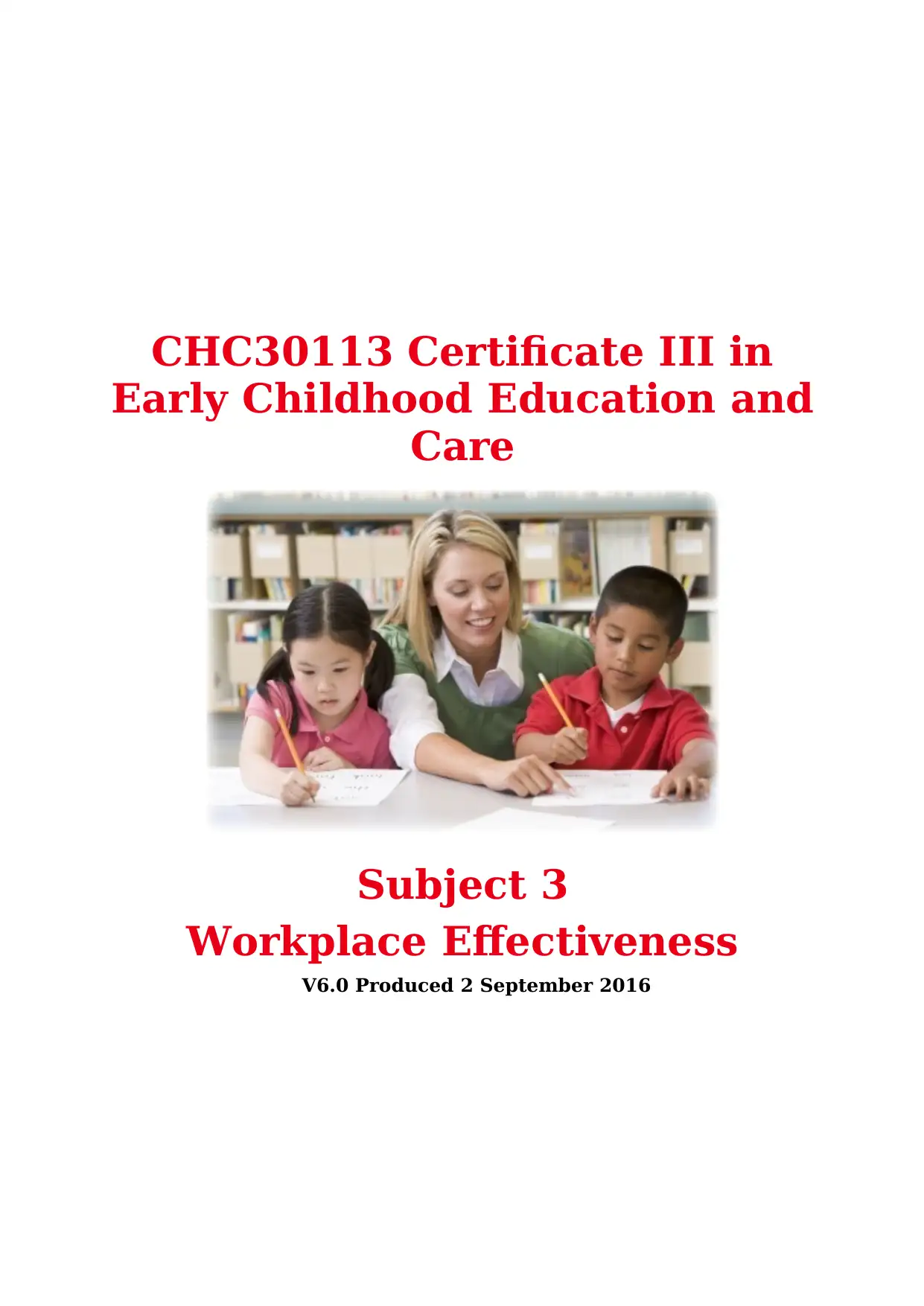
CHC30113 Certificate III in
Early Childhood Education and
Care
Subject 3
Workplace Effectiveness
V6.0 Produced 2 September 2016
Early Childhood Education and
Care
Subject 3
Workplace Effectiveness
V6.0 Produced 2 September 2016
Paraphrase This Document
Need a fresh take? Get an instant paraphrase of this document with our AI Paraphraser
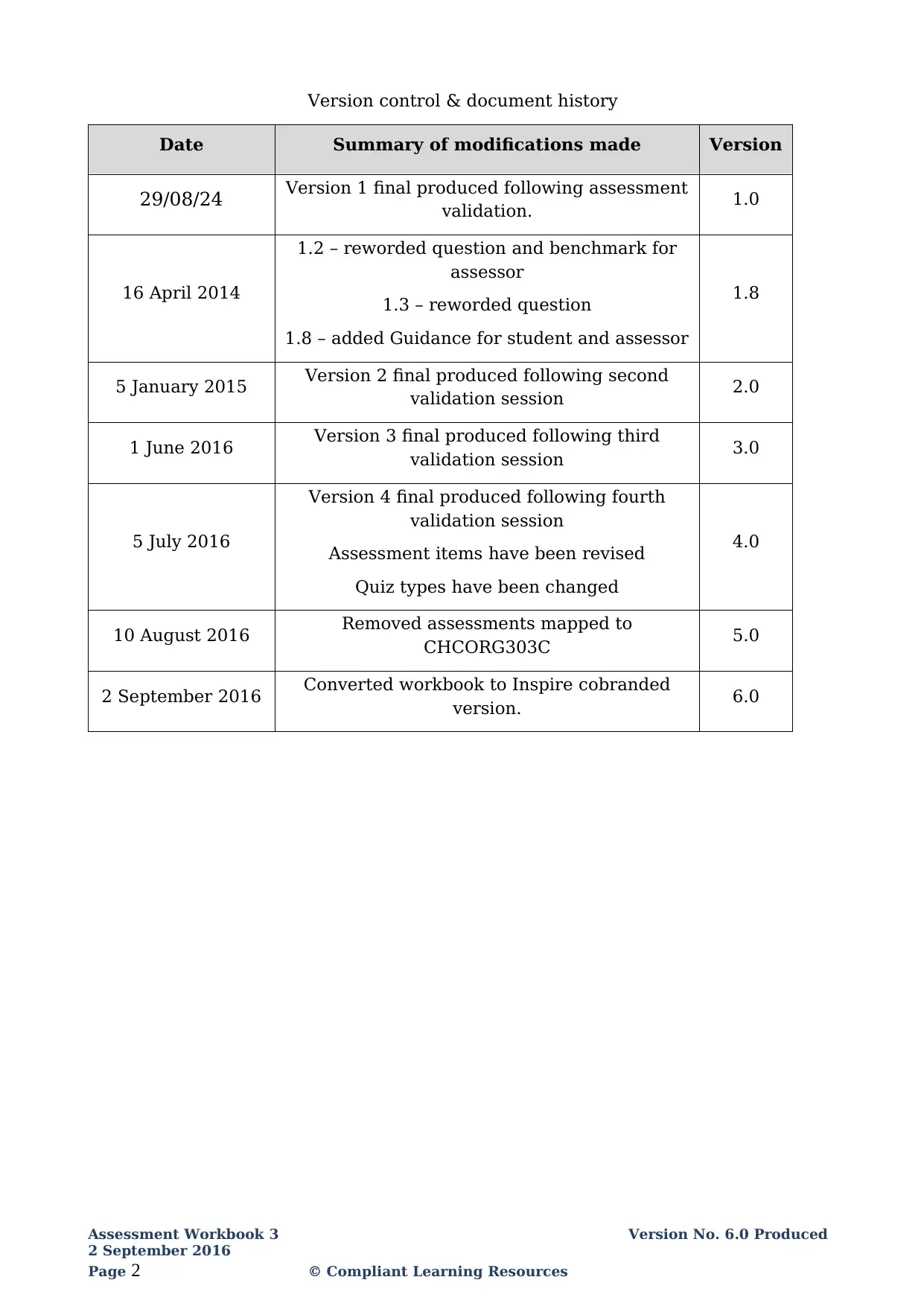
Version control & document history
Date Summary of modifications made Version
29/08/24 Version 1 final produced following assessment
validation. 1.0
16 April 2014
1.2 – reworded question and benchmark for
assessor
1.3 – reworded question
1.8 – added Guidance for student and assessor
1.8
5 January 2015 Version 2 final produced following second
validation session 2.0
1 June 2016 Version 3 final produced following third
validation session 3.0
5 July 2016
Version 4 final produced following fourth
validation session
Assessment items have been revised
Quiz types have been changed
4.0
10 August 2016 Removed assessments mapped to
CHCORG303C 5.0
2 September 2016 Converted workbook to Inspire cobranded
version. 6.0
Assessment Workbook 3 Version No. 6.0 Produced
2 September 2016
Page 2 © Compliant Learning Resources
Date Summary of modifications made Version
29/08/24 Version 1 final produced following assessment
validation. 1.0
16 April 2014
1.2 – reworded question and benchmark for
assessor
1.3 – reworded question
1.8 – added Guidance for student and assessor
1.8
5 January 2015 Version 2 final produced following second
validation session 2.0
1 June 2016 Version 3 final produced following third
validation session 3.0
5 July 2016
Version 4 final produced following fourth
validation session
Assessment items have been revised
Quiz types have been changed
4.0
10 August 2016 Removed assessments mapped to
CHCORG303C 5.0
2 September 2016 Converted workbook to Inspire cobranded
version. 6.0
Assessment Workbook 3 Version No. 6.0 Produced
2 September 2016
Page 2 © Compliant Learning Resources
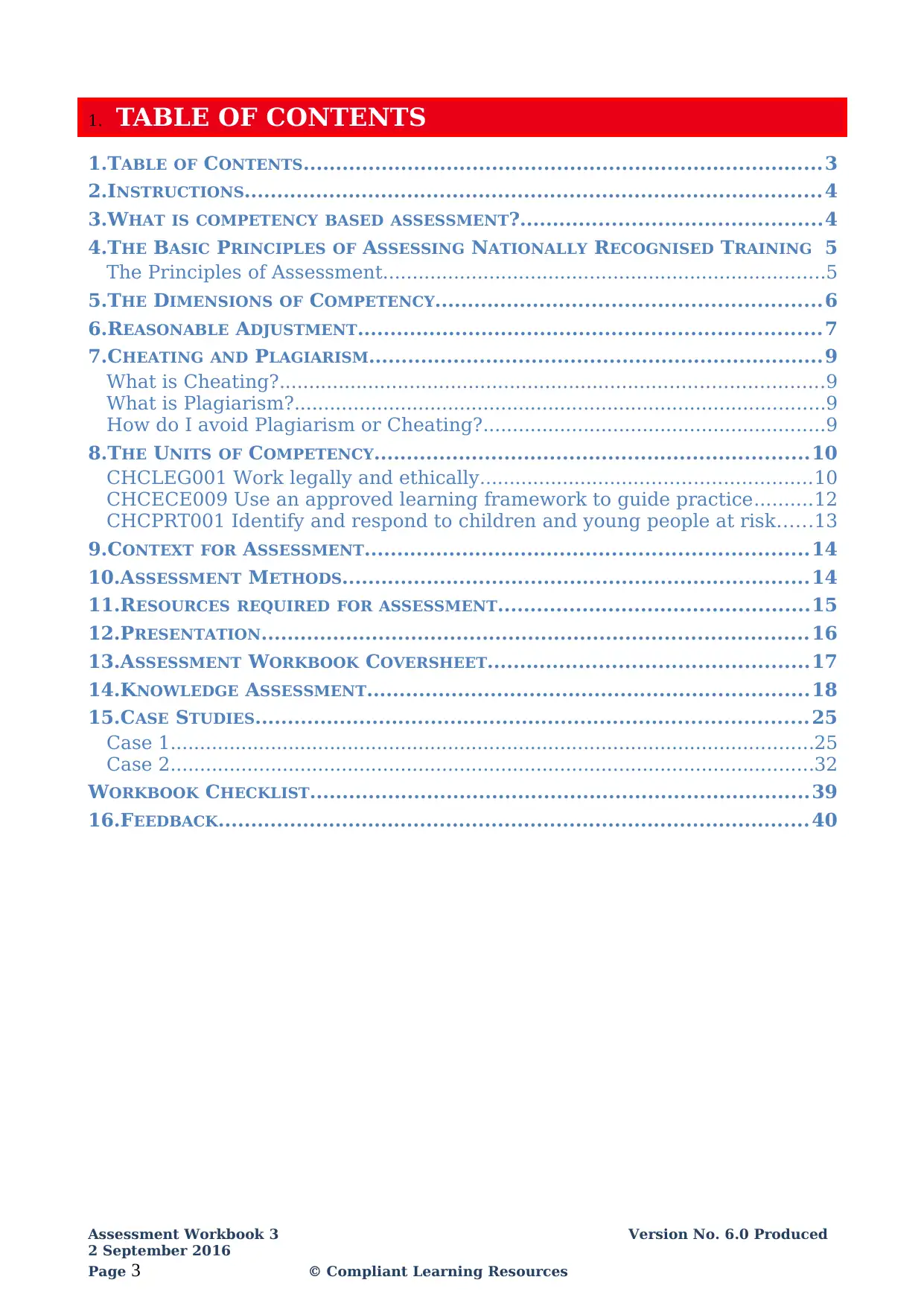
1. TABLE OF CONTENTS
1.TABLE OF CONTENTS................................................................................3
2.INSTRUCTIONS.........................................................................................4
3.WHAT IS COMPETENCY BASED ASSESSMENT?..............................................4
4.THE BASIC PRINCIPLES OF ASSESSING NATIONALLY RECOGNISED TRAINING 5
The Principles of Assessment...........................................................................5
5.THE DIMENSIONS OF COMPETENCY...........................................................6
6.REASONABLE ADJUSTMENT.......................................................................7
7.CHEATING AND PLAGIARISM......................................................................9
What is Cheating?............................................................................................9
What is Plagiarism?..........................................................................................9
How do I avoid Plagiarism or Cheating?..........................................................9
8.THE UNITS OF COMPETENCY...................................................................10
CHCLEG001 Work legally and ethically........................................................10
CHCECE009 Use an approved learning framework to guide practice..........12
CHCPRT001 Identify and respond to children and young people at risk......13
9.CONTEXT FOR ASSESSMENT....................................................................14
10.ASSESSMENT METHODS........................................................................14
11.RESOURCES REQUIRED FOR ASSESSMENT................................................15
12.PRESENTATION....................................................................................16
13.ASSESSMENT WORKBOOK COVERSHEET.................................................17
14.KNOWLEDGE ASSESSMENT....................................................................18
15.CASE STUDIES.....................................................................................25
Case 1.............................................................................................................25
Case 2.............................................................................................................32
WORKBOOK CHECKLIST.............................................................................39
16.FEEDBACK........................................................................................... 40
Assessment Workbook 3 Version No. 6.0 Produced
2 September 2016
Page 3 © Compliant Learning Resources
1.TABLE OF CONTENTS................................................................................3
2.INSTRUCTIONS.........................................................................................4
3.WHAT IS COMPETENCY BASED ASSESSMENT?..............................................4
4.THE BASIC PRINCIPLES OF ASSESSING NATIONALLY RECOGNISED TRAINING 5
The Principles of Assessment...........................................................................5
5.THE DIMENSIONS OF COMPETENCY...........................................................6
6.REASONABLE ADJUSTMENT.......................................................................7
7.CHEATING AND PLAGIARISM......................................................................9
What is Cheating?............................................................................................9
What is Plagiarism?..........................................................................................9
How do I avoid Plagiarism or Cheating?..........................................................9
8.THE UNITS OF COMPETENCY...................................................................10
CHCLEG001 Work legally and ethically........................................................10
CHCECE009 Use an approved learning framework to guide practice..........12
CHCPRT001 Identify and respond to children and young people at risk......13
9.CONTEXT FOR ASSESSMENT....................................................................14
10.ASSESSMENT METHODS........................................................................14
11.RESOURCES REQUIRED FOR ASSESSMENT................................................15
12.PRESENTATION....................................................................................16
13.ASSESSMENT WORKBOOK COVERSHEET.................................................17
14.KNOWLEDGE ASSESSMENT....................................................................18
15.CASE STUDIES.....................................................................................25
Case 1.............................................................................................................25
Case 2.............................................................................................................32
WORKBOOK CHECKLIST.............................................................................39
16.FEEDBACK........................................................................................... 40
Assessment Workbook 3 Version No. 6.0 Produced
2 September 2016
Page 3 © Compliant Learning Resources
⊘ This is a preview!⊘
Do you want full access?
Subscribe today to unlock all pages.

Trusted by 1+ million students worldwide
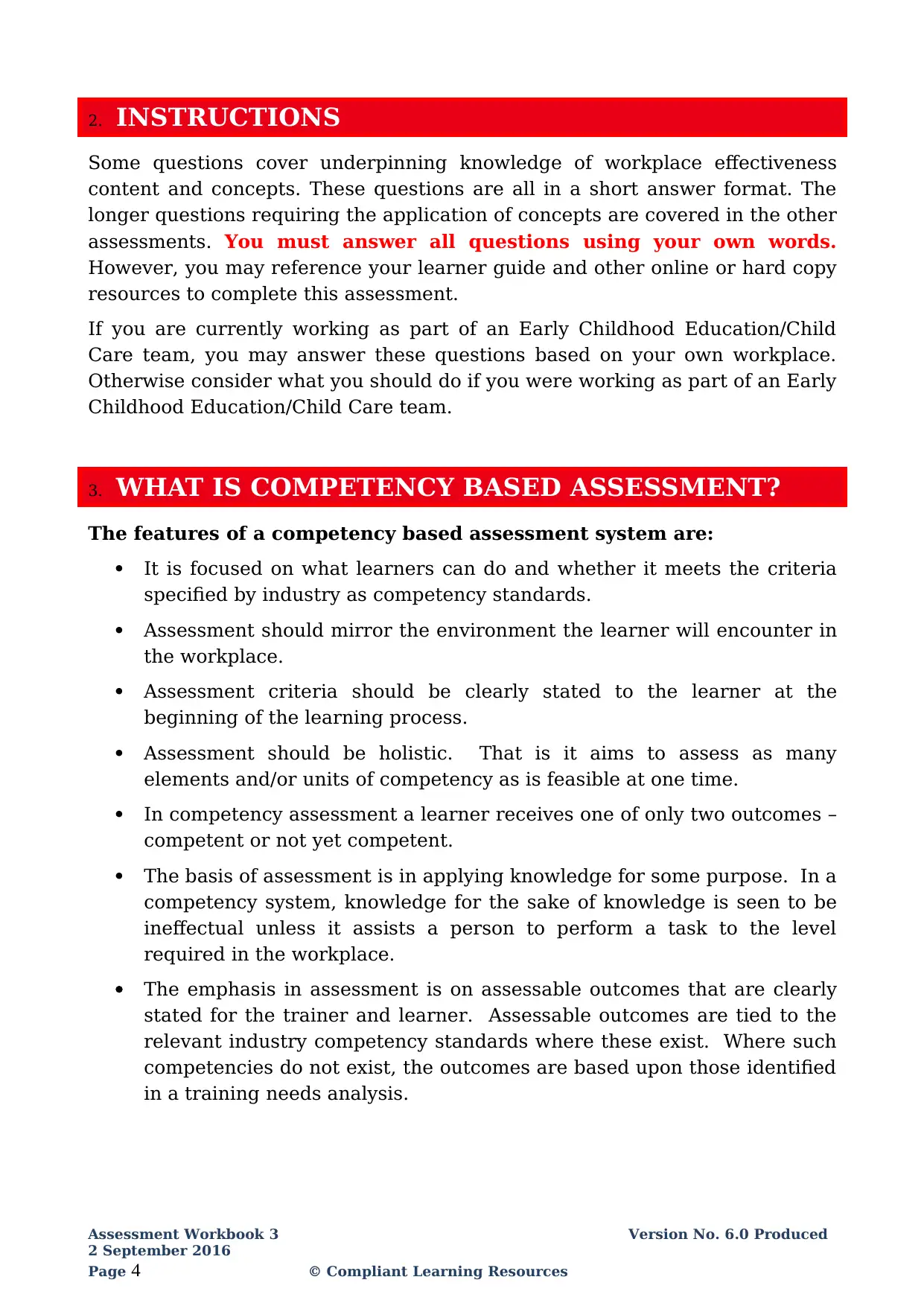
2. INSTRUCTIONS
Some questions cover underpinning knowledge of workplace effectiveness
content and concepts. These questions are all in a short answer format. The
longer questions requiring the application of concepts are covered in the other
assessments. You must answer all questions using your own words.
However, you may reference your learner guide and other online or hard copy
resources to complete this assessment.
If you are currently working as part of an Early Childhood Education/Child
Care team, you may answer these questions based on your own workplace.
Otherwise consider what you should do if you were working as part of an Early
Childhood Education/Child Care team.
3. WHAT IS COMPETENCY BASED ASSESSMENT?
The features of a competency based assessment system are:
It is focused on what learners can do and whether it meets the criteria
specified by industry as competency standards.
Assessment should mirror the environment the learner will encounter in
the workplace.
Assessment criteria should be clearly stated to the learner at the
beginning of the learning process.
Assessment should be holistic. That is it aims to assess as many
elements and/or units of competency as is feasible at one time.
In competency assessment a learner receives one of only two outcomes –
competent or not yet competent.
The basis of assessment is in applying knowledge for some purpose. In a
competency system, knowledge for the sake of knowledge is seen to be
ineffectual unless it assists a person to perform a task to the level
required in the workplace.
The emphasis in assessment is on assessable outcomes that are clearly
stated for the trainer and learner. Assessable outcomes are tied to the
relevant industry competency standards where these exist. Where such
competencies do not exist, the outcomes are based upon those identified
in a training needs analysis.
Assessment Workbook 3 Version No. 6.0 Produced
2 September 2016
Page 4 © Compliant Learning Resources
Some questions cover underpinning knowledge of workplace effectiveness
content and concepts. These questions are all in a short answer format. The
longer questions requiring the application of concepts are covered in the other
assessments. You must answer all questions using your own words.
However, you may reference your learner guide and other online or hard copy
resources to complete this assessment.
If you are currently working as part of an Early Childhood Education/Child
Care team, you may answer these questions based on your own workplace.
Otherwise consider what you should do if you were working as part of an Early
Childhood Education/Child Care team.
3. WHAT IS COMPETENCY BASED ASSESSMENT?
The features of a competency based assessment system are:
It is focused on what learners can do and whether it meets the criteria
specified by industry as competency standards.
Assessment should mirror the environment the learner will encounter in
the workplace.
Assessment criteria should be clearly stated to the learner at the
beginning of the learning process.
Assessment should be holistic. That is it aims to assess as many
elements and/or units of competency as is feasible at one time.
In competency assessment a learner receives one of only two outcomes –
competent or not yet competent.
The basis of assessment is in applying knowledge for some purpose. In a
competency system, knowledge for the sake of knowledge is seen to be
ineffectual unless it assists a person to perform a task to the level
required in the workplace.
The emphasis in assessment is on assessable outcomes that are clearly
stated for the trainer and learner. Assessable outcomes are tied to the
relevant industry competency standards where these exist. Where such
competencies do not exist, the outcomes are based upon those identified
in a training needs analysis.
Assessment Workbook 3 Version No. 6.0 Produced
2 September 2016
Page 4 © Compliant Learning Resources
Paraphrase This Document
Need a fresh take? Get an instant paraphrase of this document with our AI Paraphraser
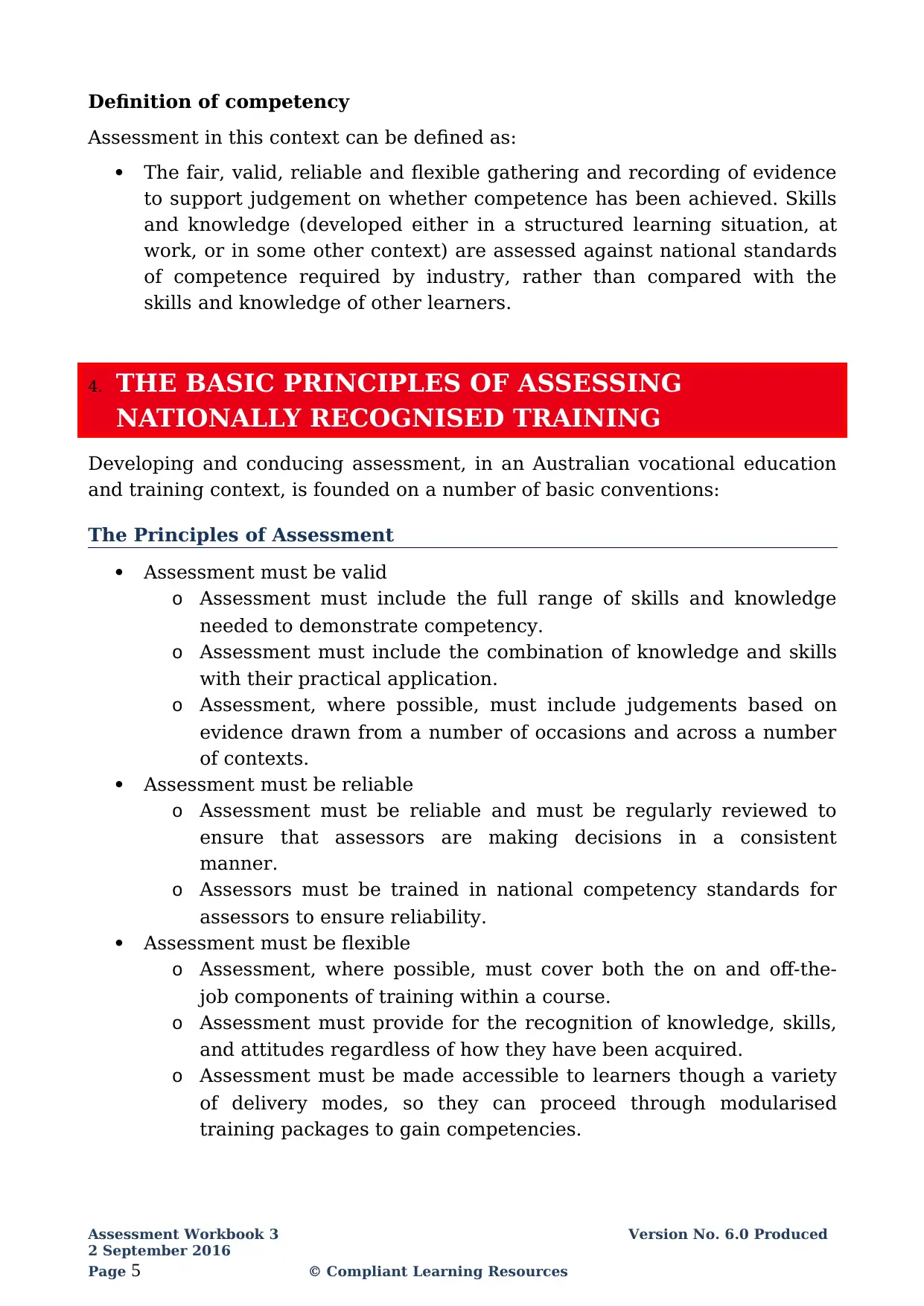
Definition of competency
Assessment in this context can be defined as:
The fair, valid, reliable and flexible gathering and recording of evidence
to support judgement on whether competence has been achieved. Skills
and knowledge (developed either in a structured learning situation, at
work, or in some other context) are assessed against national standards
of competence required by industry, rather than compared with the
skills and knowledge of other learners.
4. THE BASIC PRINCIPLES OF ASSESSING
NATIONALLY RECOGNISED TRAINING
Developing and conducing assessment, in an Australian vocational education
and training context, is founded on a number of basic conventions:
The Principles of Assessment
Assessment must be valid
o Assessment must include the full range of skills and knowledge
needed to demonstrate competency.
o Assessment must include the combination of knowledge and skills
with their practical application.
o Assessment, where possible, must include judgements based on
evidence drawn from a number of occasions and across a number
of contexts.
Assessment must be reliable
o Assessment must be reliable and must be regularly reviewed to
ensure that assessors are making decisions in a consistent
manner.
o Assessors must be trained in national competency standards for
assessors to ensure reliability.
Assessment must be flexible
o Assessment, where possible, must cover both the on and off-the-
job components of training within a course.
o Assessment must provide for the recognition of knowledge, skills,
and attitudes regardless of how they have been acquired.
o Assessment must be made accessible to learners though a variety
of delivery modes, so they can proceed through modularised
training packages to gain competencies.
Assessment Workbook 3 Version No. 6.0 Produced
2 September 2016
Page 5 © Compliant Learning Resources
Assessment in this context can be defined as:
The fair, valid, reliable and flexible gathering and recording of evidence
to support judgement on whether competence has been achieved. Skills
and knowledge (developed either in a structured learning situation, at
work, or in some other context) are assessed against national standards
of competence required by industry, rather than compared with the
skills and knowledge of other learners.
4. THE BASIC PRINCIPLES OF ASSESSING
NATIONALLY RECOGNISED TRAINING
Developing and conducing assessment, in an Australian vocational education
and training context, is founded on a number of basic conventions:
The Principles of Assessment
Assessment must be valid
o Assessment must include the full range of skills and knowledge
needed to demonstrate competency.
o Assessment must include the combination of knowledge and skills
with their practical application.
o Assessment, where possible, must include judgements based on
evidence drawn from a number of occasions and across a number
of contexts.
Assessment must be reliable
o Assessment must be reliable and must be regularly reviewed to
ensure that assessors are making decisions in a consistent
manner.
o Assessors must be trained in national competency standards for
assessors to ensure reliability.
Assessment must be flexible
o Assessment, where possible, must cover both the on and off-the-
job components of training within a course.
o Assessment must provide for the recognition of knowledge, skills,
and attitudes regardless of how they have been acquired.
o Assessment must be made accessible to learners though a variety
of delivery modes, so they can proceed through modularised
training packages to gain competencies.
Assessment Workbook 3 Version No. 6.0 Produced
2 September 2016
Page 5 © Compliant Learning Resources
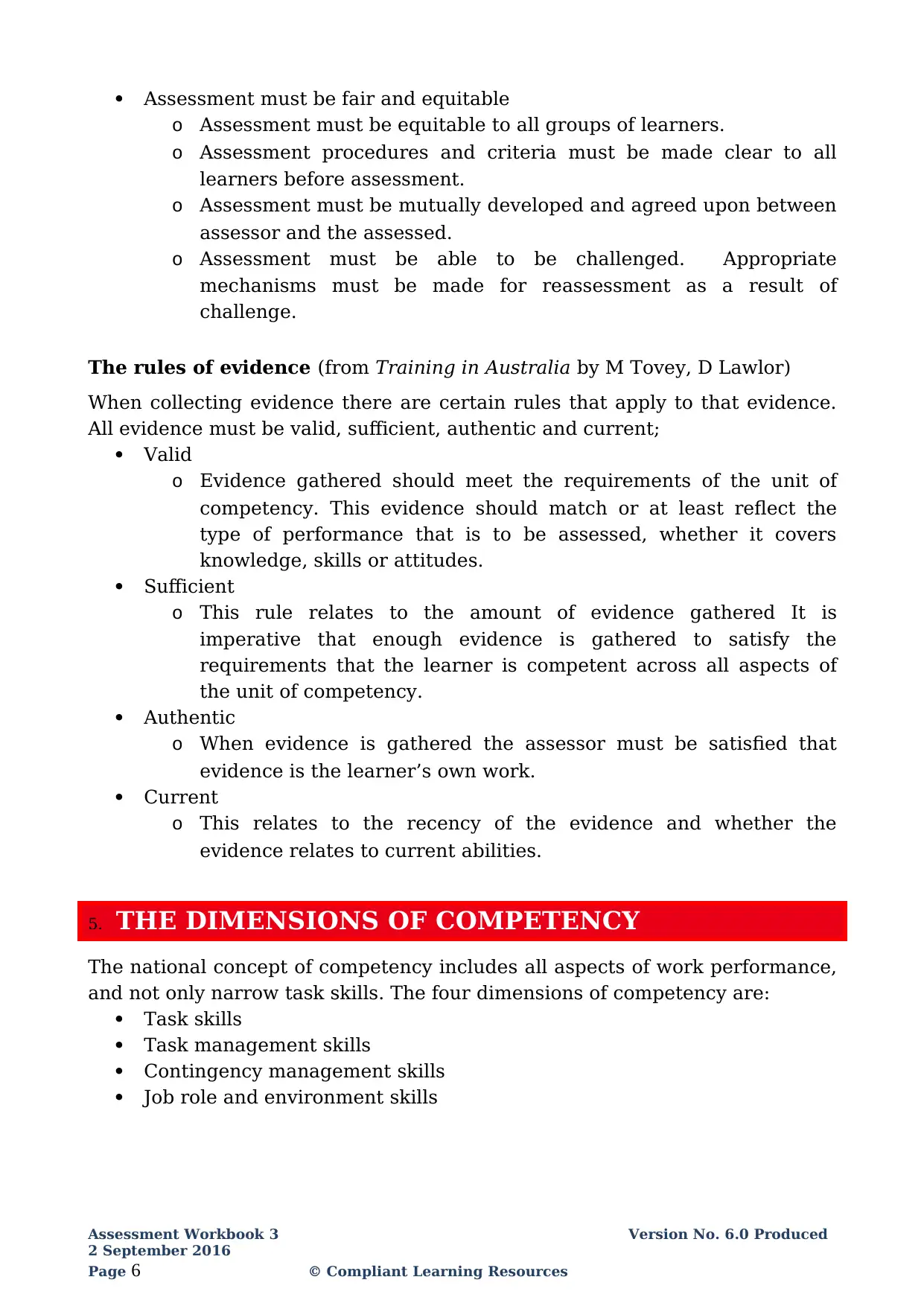
Assessment must be fair and equitable
o Assessment must be equitable to all groups of learners.
o Assessment procedures and criteria must be made clear to all
learners before assessment.
o Assessment must be mutually developed and agreed upon between
assessor and the assessed.
o Assessment must be able to be challenged. Appropriate
mechanisms must be made for reassessment as a result of
challenge.
The rules of evidence (from Training in Australia by M Tovey, D Lawlor)
When collecting evidence there are certain rules that apply to that evidence.
All evidence must be valid, sufficient, authentic and current;
Valid
o Evidence gathered should meet the requirements of the unit of
competency. This evidence should match or at least reflect the
type of performance that is to be assessed, whether it covers
knowledge, skills or attitudes.
Sufficient
o This rule relates to the amount of evidence gathered It is
imperative that enough evidence is gathered to satisfy the
requirements that the learner is competent across all aspects of
the unit of competency.
Authentic
o When evidence is gathered the assessor must be satisfied that
evidence is the learner’s own work.
Current
o This relates to the recency of the evidence and whether the
evidence relates to current abilities.
5. THE DIMENSIONS OF COMPETENCY
The national concept of competency includes all aspects of work performance,
and not only narrow task skills. The four dimensions of competency are:
Task skills
Task management skills
Contingency management skills
Job role and environment skills
Assessment Workbook 3 Version No. 6.0 Produced
2 September 2016
Page 6 © Compliant Learning Resources
o Assessment must be equitable to all groups of learners.
o Assessment procedures and criteria must be made clear to all
learners before assessment.
o Assessment must be mutually developed and agreed upon between
assessor and the assessed.
o Assessment must be able to be challenged. Appropriate
mechanisms must be made for reassessment as a result of
challenge.
The rules of evidence (from Training in Australia by M Tovey, D Lawlor)
When collecting evidence there are certain rules that apply to that evidence.
All evidence must be valid, sufficient, authentic and current;
Valid
o Evidence gathered should meet the requirements of the unit of
competency. This evidence should match or at least reflect the
type of performance that is to be assessed, whether it covers
knowledge, skills or attitudes.
Sufficient
o This rule relates to the amount of evidence gathered It is
imperative that enough evidence is gathered to satisfy the
requirements that the learner is competent across all aspects of
the unit of competency.
Authentic
o When evidence is gathered the assessor must be satisfied that
evidence is the learner’s own work.
Current
o This relates to the recency of the evidence and whether the
evidence relates to current abilities.
5. THE DIMENSIONS OF COMPETENCY
The national concept of competency includes all aspects of work performance,
and not only narrow task skills. The four dimensions of competency are:
Task skills
Task management skills
Contingency management skills
Job role and environment skills
Assessment Workbook 3 Version No. 6.0 Produced
2 September 2016
Page 6 © Compliant Learning Resources
⊘ This is a preview!⊘
Do you want full access?
Subscribe today to unlock all pages.

Trusted by 1+ million students worldwide
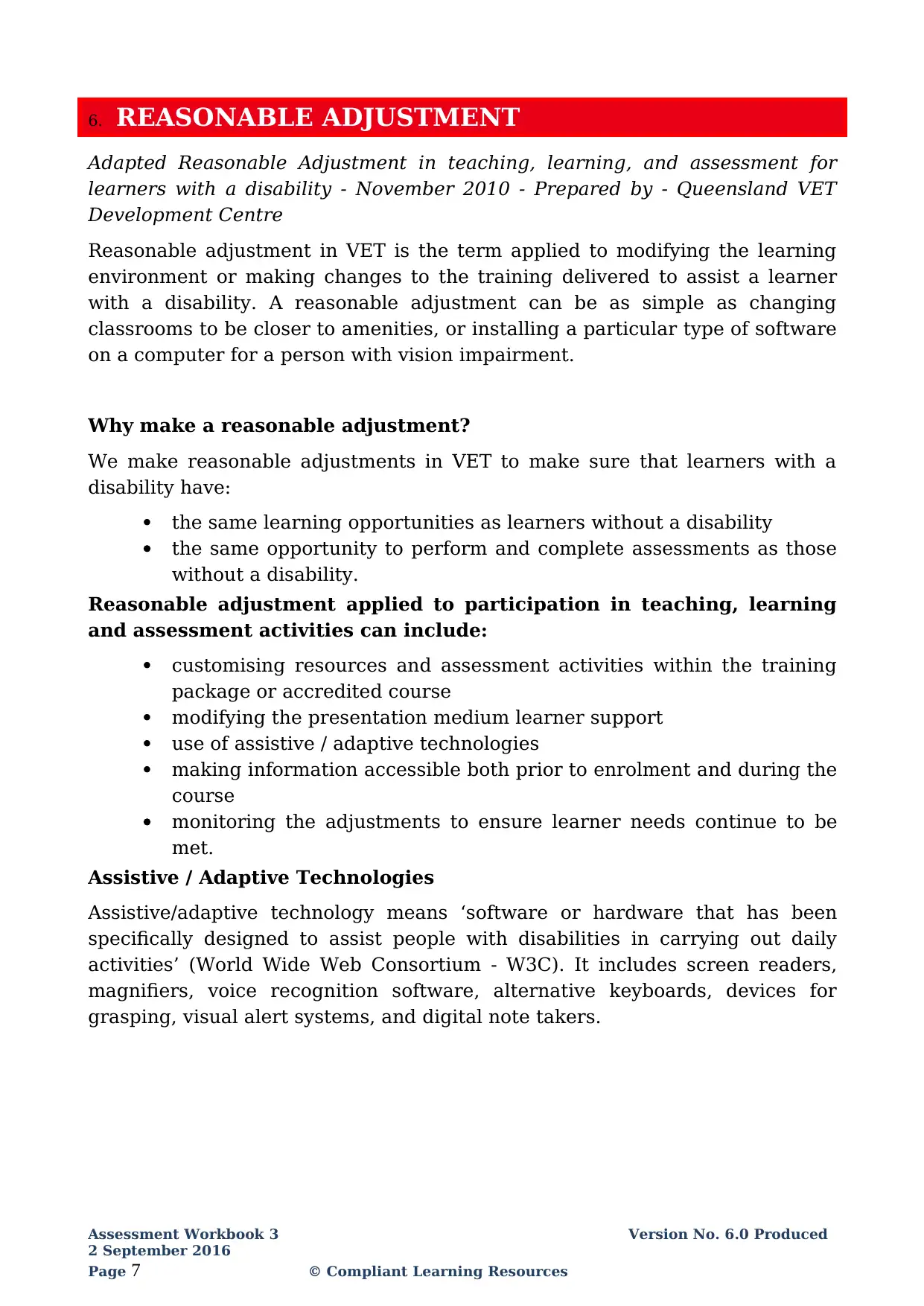
6. REASONABLE ADJUSTMENT
Adapted Reasonable Adjustment in teaching, learning, and assessment for
learners with a disability - November 2010 - Prepared by - Queensland VET
Development Centre
Reasonable adjustment in VET is the term applied to modifying the learning
environment or making changes to the training delivered to assist a learner
with a disability. A reasonable adjustment can be as simple as changing
classrooms to be closer to amenities, or installing a particular type of software
on a computer for a person with vision impairment.
Why make a reasonable adjustment?
We make reasonable adjustments in VET to make sure that learners with a
disability have:
the same learning opportunities as learners without a disability
the same opportunity to perform and complete assessments as those
without a disability.
Reasonable adjustment applied to participation in teaching, learning
and assessment activities can include:
customising resources and assessment activities within the training
package or accredited course
modifying the presentation medium learner support
use of assistive / adaptive technologies
making information accessible both prior to enrolment and during the
course
monitoring the adjustments to ensure learner needs continue to be
met.
Assistive / Adaptive Technologies
Assistive/adaptive technology means ‘software or hardware that has been
specifically designed to assist people with disabilities in carrying out daily
activities’ (World Wide Web Consortium - W3C). It includes screen readers,
magnifiers, voice recognition software, alternative keyboards, devices for
grasping, visual alert systems, and digital note takers.
Assessment Workbook 3 Version No. 6.0 Produced
2 September 2016
Page 7 © Compliant Learning Resources
Adapted Reasonable Adjustment in teaching, learning, and assessment for
learners with a disability - November 2010 - Prepared by - Queensland VET
Development Centre
Reasonable adjustment in VET is the term applied to modifying the learning
environment or making changes to the training delivered to assist a learner
with a disability. A reasonable adjustment can be as simple as changing
classrooms to be closer to amenities, or installing a particular type of software
on a computer for a person with vision impairment.
Why make a reasonable adjustment?
We make reasonable adjustments in VET to make sure that learners with a
disability have:
the same learning opportunities as learners without a disability
the same opportunity to perform and complete assessments as those
without a disability.
Reasonable adjustment applied to participation in teaching, learning
and assessment activities can include:
customising resources and assessment activities within the training
package or accredited course
modifying the presentation medium learner support
use of assistive / adaptive technologies
making information accessible both prior to enrolment and during the
course
monitoring the adjustments to ensure learner needs continue to be
met.
Assistive / Adaptive Technologies
Assistive/adaptive technology means ‘software or hardware that has been
specifically designed to assist people with disabilities in carrying out daily
activities’ (World Wide Web Consortium - W3C). It includes screen readers,
magnifiers, voice recognition software, alternative keyboards, devices for
grasping, visual alert systems, and digital note takers.
Assessment Workbook 3 Version No. 6.0 Produced
2 September 2016
Page 7 © Compliant Learning Resources
Paraphrase This Document
Need a fresh take? Get an instant paraphrase of this document with our AI Paraphraser
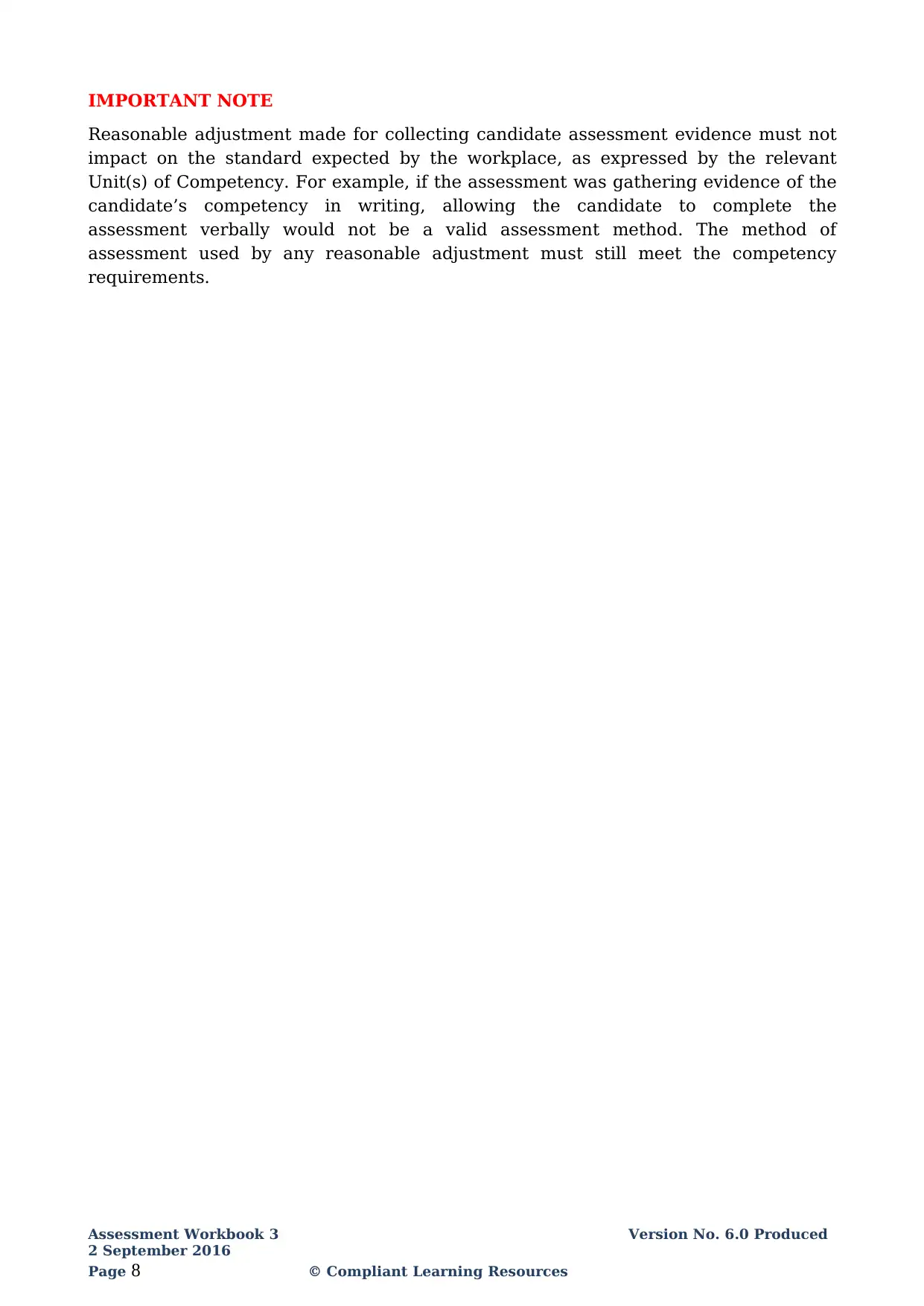
IMPORTANT NOTE
Reasonable adjustment made for collecting candidate assessment evidence must not
impact on the standard expected by the workplace, as expressed by the relevant
Unit(s) of Competency. For example, if the assessment was gathering evidence of the
candidate’s competency in writing, allowing the candidate to complete the
assessment verbally would not be a valid assessment method. The method of
assessment used by any reasonable adjustment must still meet the competency
requirements.
Assessment Workbook 3 Version No. 6.0 Produced
2 September 2016
Page 8 © Compliant Learning Resources
Reasonable adjustment made for collecting candidate assessment evidence must not
impact on the standard expected by the workplace, as expressed by the relevant
Unit(s) of Competency. For example, if the assessment was gathering evidence of the
candidate’s competency in writing, allowing the candidate to complete the
assessment verbally would not be a valid assessment method. The method of
assessment used by any reasonable adjustment must still meet the competency
requirements.
Assessment Workbook 3 Version No. 6.0 Produced
2 September 2016
Page 8 © Compliant Learning Resources
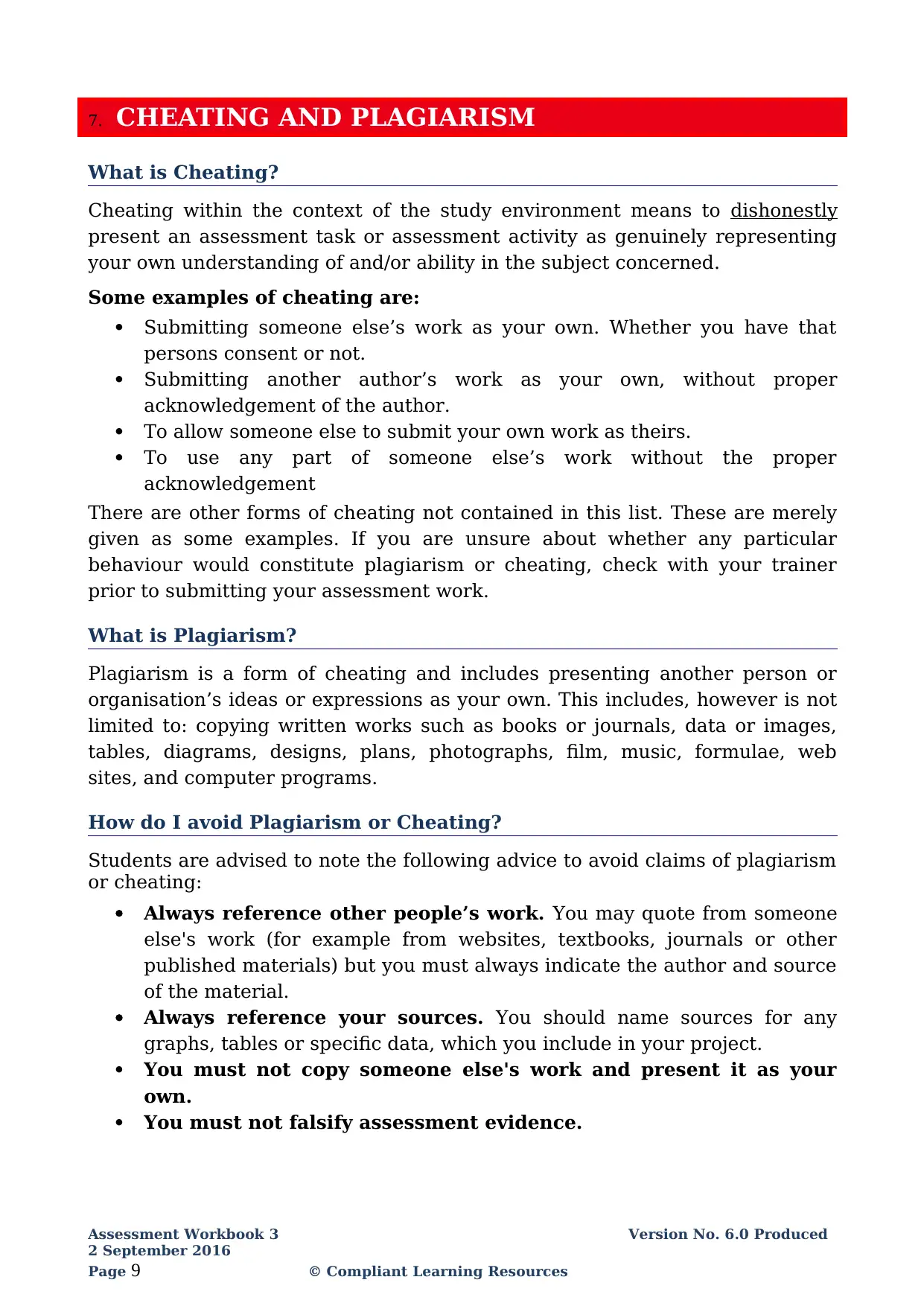
7. CHEATING AND PLAGIARISM
What is Cheating?
Cheating within the context of the study environment means to dishonestly
present an assessment task or assessment activity as genuinely representing
your own understanding of and/or ability in the subject concerned.
Some examples of cheating are:
Submitting someone else’s work as your own. Whether you have that
persons consent or not.
Submitting another author’s work as your own, without proper
acknowledgement of the author.
To allow someone else to submit your own work as theirs.
To use any part of someone else’s work without the proper
acknowledgement
There are other forms of cheating not contained in this list. These are merely
given as some examples. If you are unsure about whether any particular
behaviour would constitute plagiarism or cheating, check with your trainer
prior to submitting your assessment work.
What is Plagiarism?
Plagiarism is a form of cheating and includes presenting another person or
organisation’s ideas or expressions as your own. This includes, however is not
limited to: copying written works such as books or journals, data or images,
tables, diagrams, designs, plans, photographs, film, music, formulae, web
sites, and computer programs.
How do I avoid Plagiarism or Cheating?
Students are advised to note the following advice to avoid claims of plagiarism
or cheating:
Always reference other people’s work. You may quote from someone
else's work (for example from websites, textbooks, journals or other
published materials) but you must always indicate the author and source
of the material.
Always reference your sources. You should name sources for any
graphs, tables or specific data, which you include in your project.
You must not copy someone else's work and present it as your
own.
You must not falsify assessment evidence.
Assessment Workbook 3 Version No. 6.0 Produced
2 September 2016
Page 9 © Compliant Learning Resources
What is Cheating?
Cheating within the context of the study environment means to dishonestly
present an assessment task or assessment activity as genuinely representing
your own understanding of and/or ability in the subject concerned.
Some examples of cheating are:
Submitting someone else’s work as your own. Whether you have that
persons consent or not.
Submitting another author’s work as your own, without proper
acknowledgement of the author.
To allow someone else to submit your own work as theirs.
To use any part of someone else’s work without the proper
acknowledgement
There are other forms of cheating not contained in this list. These are merely
given as some examples. If you are unsure about whether any particular
behaviour would constitute plagiarism or cheating, check with your trainer
prior to submitting your assessment work.
What is Plagiarism?
Plagiarism is a form of cheating and includes presenting another person or
organisation’s ideas or expressions as your own. This includes, however is not
limited to: copying written works such as books or journals, data or images,
tables, diagrams, designs, plans, photographs, film, music, formulae, web
sites, and computer programs.
How do I avoid Plagiarism or Cheating?
Students are advised to note the following advice to avoid claims of plagiarism
or cheating:
Always reference other people’s work. You may quote from someone
else's work (for example from websites, textbooks, journals or other
published materials) but you must always indicate the author and source
of the material.
Always reference your sources. You should name sources for any
graphs, tables or specific data, which you include in your project.
You must not copy someone else's work and present it as your
own.
You must not falsify assessment evidence.
Assessment Workbook 3 Version No. 6.0 Produced
2 September 2016
Page 9 © Compliant Learning Resources
⊘ This is a preview!⊘
Do you want full access?
Subscribe today to unlock all pages.

Trusted by 1+ million students worldwide
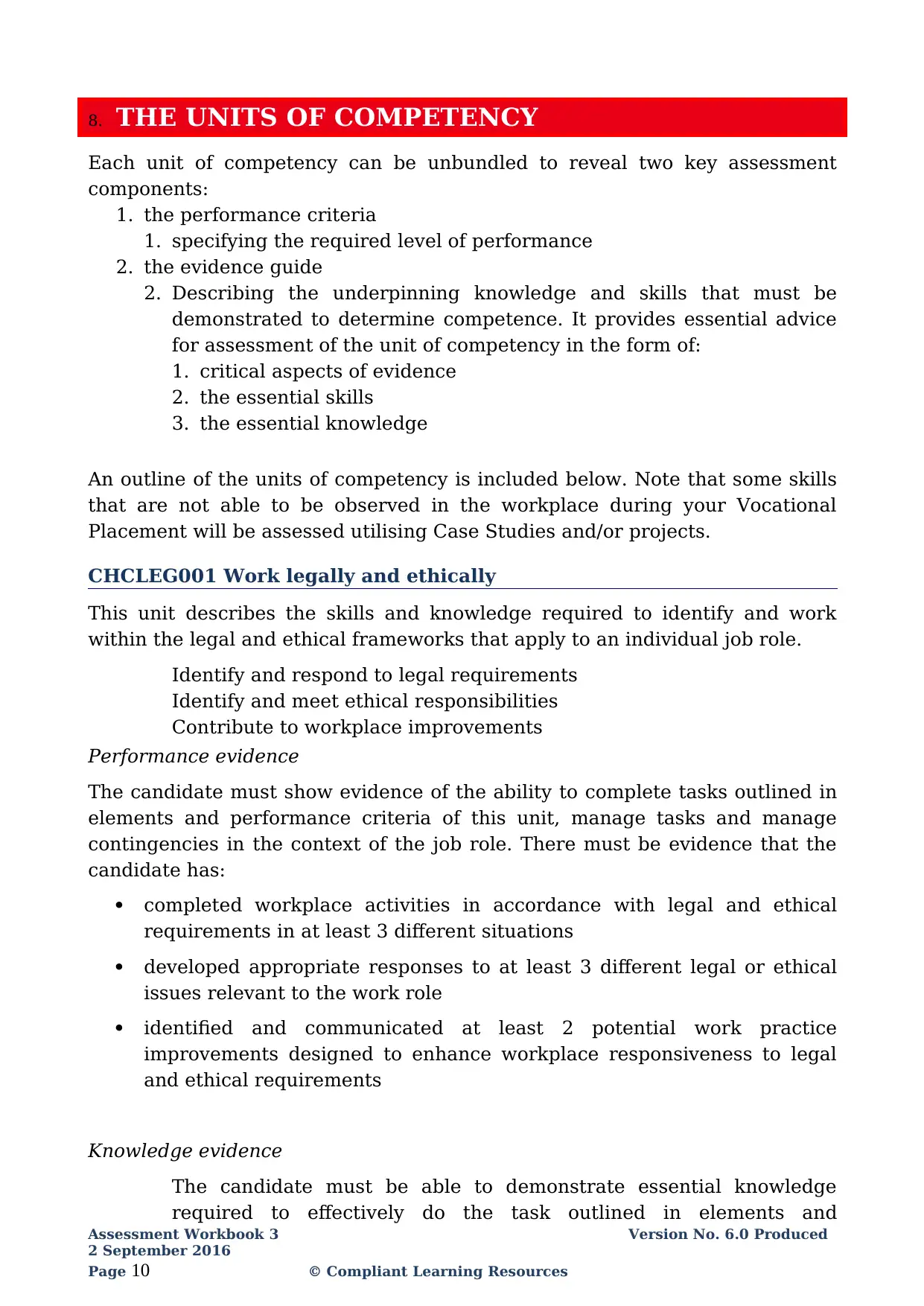
8. THE UNITS OF COMPETENCY
Each unit of competency can be unbundled to reveal two key assessment
components:
1. the performance criteria
1. specifying the required level of performance
2. the evidence guide
2. Describing the underpinning knowledge and skills that must be
demonstrated to determine competence. It provides essential advice
for assessment of the unit of competency in the form of:
1. critical aspects of evidence
2. the essential skills
3. the essential knowledge
An outline of the units of competency is included below. Note that some skills
that are not able to be observed in the workplace during your Vocational
Placement will be assessed utilising Case Studies and/or projects.
CHCLEG001 Work legally and ethically
This unit describes the skills and knowledge required to identify and work
within the legal and ethical frameworks that apply to an individual job role.
Identify and respond to legal requirements
Identify and meet ethical responsibilities
Contribute to workplace improvements
Performance evidence
The candidate must show evidence of the ability to complete tasks outlined in
elements and performance criteria of this unit, manage tasks and manage
contingencies in the context of the job role. There must be evidence that the
candidate has:
completed workplace activities in accordance with legal and ethical
requirements in at least 3 different situations
developed appropriate responses to at least 3 different legal or ethical
issues relevant to the work role
identified and communicated at least 2 potential work practice
improvements designed to enhance workplace responsiveness to legal
and ethical requirements
Knowledge evidence
The candidate must be able to demonstrate essential knowledge
required to effectively do the task outlined in elements and
Assessment Workbook 3 Version No. 6.0 Produced
2 September 2016
Page 10 © Compliant Learning Resources
Each unit of competency can be unbundled to reveal two key assessment
components:
1. the performance criteria
1. specifying the required level of performance
2. the evidence guide
2. Describing the underpinning knowledge and skills that must be
demonstrated to determine competence. It provides essential advice
for assessment of the unit of competency in the form of:
1. critical aspects of evidence
2. the essential skills
3. the essential knowledge
An outline of the units of competency is included below. Note that some skills
that are not able to be observed in the workplace during your Vocational
Placement will be assessed utilising Case Studies and/or projects.
CHCLEG001 Work legally and ethically
This unit describes the skills and knowledge required to identify and work
within the legal and ethical frameworks that apply to an individual job role.
Identify and respond to legal requirements
Identify and meet ethical responsibilities
Contribute to workplace improvements
Performance evidence
The candidate must show evidence of the ability to complete tasks outlined in
elements and performance criteria of this unit, manage tasks and manage
contingencies in the context of the job role. There must be evidence that the
candidate has:
completed workplace activities in accordance with legal and ethical
requirements in at least 3 different situations
developed appropriate responses to at least 3 different legal or ethical
issues relevant to the work role
identified and communicated at least 2 potential work practice
improvements designed to enhance workplace responsiveness to legal
and ethical requirements
Knowledge evidence
The candidate must be able to demonstrate essential knowledge
required to effectively do the task outlined in elements and
Assessment Workbook 3 Version No. 6.0 Produced
2 September 2016
Page 10 © Compliant Learning Resources
Paraphrase This Document
Need a fresh take? Get an instant paraphrase of this document with our AI Paraphraser
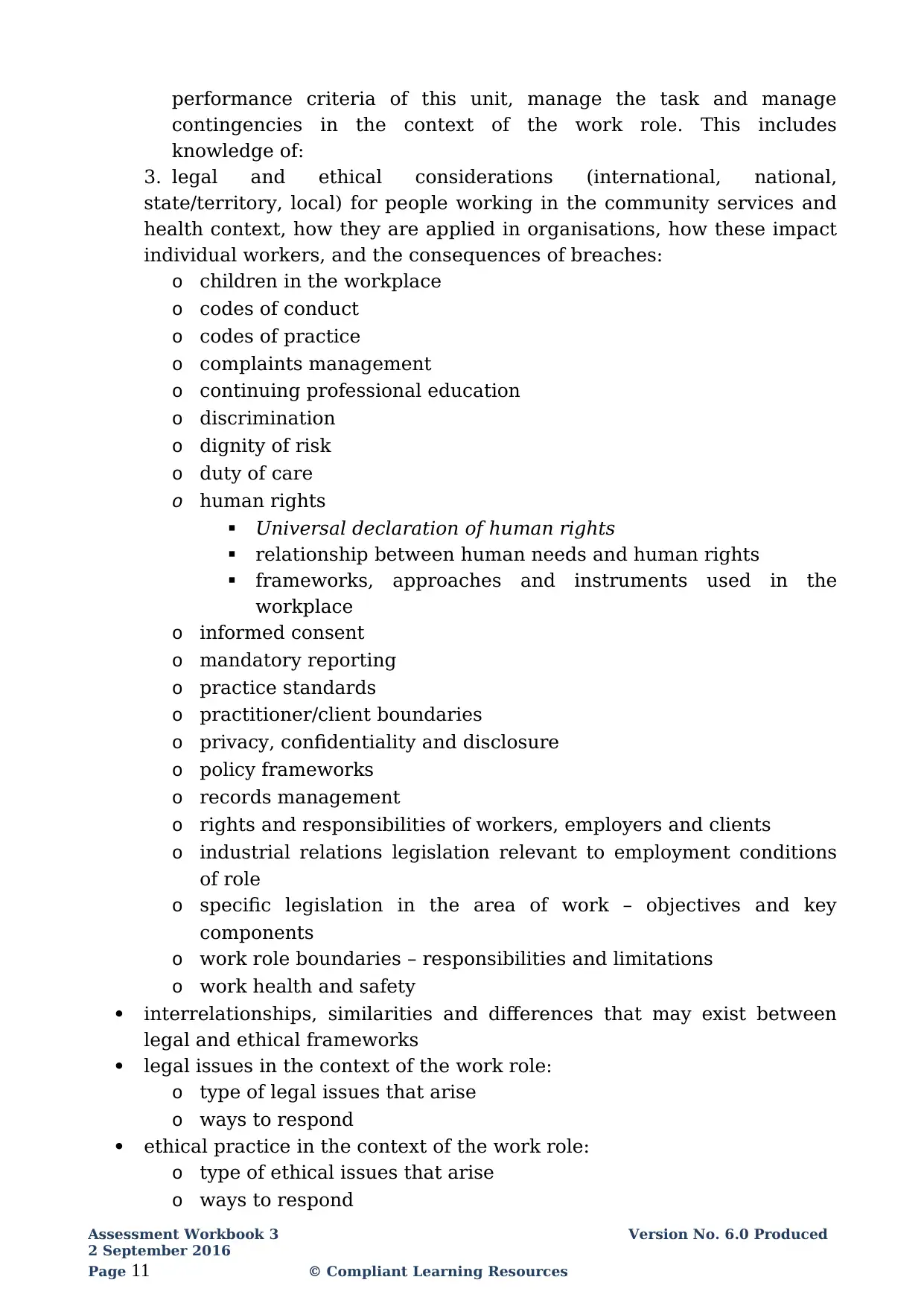
performance criteria of this unit, manage the task and manage
contingencies in the context of the work role. This includes
knowledge of:
3. legal and ethical considerations (international, national,
state/territory, local) for people working in the community services and
health context, how they are applied in organisations, how these impact
individual workers, and the consequences of breaches:
o children in the workplace
o codes of conduct
o codes of practice
o complaints management
o continuing professional education
o discrimination
o dignity of risk
o duty of care
o human rights
Universal declaration of human rights
relationship between human needs and human rights
frameworks, approaches and instruments used in the
workplace
o informed consent
o mandatory reporting
o practice standards
o practitioner/client boundaries
o privacy, confidentiality and disclosure
o policy frameworks
o records management
o rights and responsibilities of workers, employers and clients
o industrial relations legislation relevant to employment conditions
of role
o specific legislation in the area of work – objectives and key
components
o work role boundaries – responsibilities and limitations
o work health and safety
interrelationships, similarities and differences that may exist between
legal and ethical frameworks
legal issues in the context of the work role:
o type of legal issues that arise
o ways to respond
ethical practice in the context of the work role:
o type of ethical issues that arise
o ways to respond
Assessment Workbook 3 Version No. 6.0 Produced
2 September 2016
Page 11 © Compliant Learning Resources
contingencies in the context of the work role. This includes
knowledge of:
3. legal and ethical considerations (international, national,
state/territory, local) for people working in the community services and
health context, how they are applied in organisations, how these impact
individual workers, and the consequences of breaches:
o children in the workplace
o codes of conduct
o codes of practice
o complaints management
o continuing professional education
o discrimination
o dignity of risk
o duty of care
o human rights
Universal declaration of human rights
relationship between human needs and human rights
frameworks, approaches and instruments used in the
workplace
o informed consent
o mandatory reporting
o practice standards
o practitioner/client boundaries
o privacy, confidentiality and disclosure
o policy frameworks
o records management
o rights and responsibilities of workers, employers and clients
o industrial relations legislation relevant to employment conditions
of role
o specific legislation in the area of work – objectives and key
components
o work role boundaries – responsibilities and limitations
o work health and safety
interrelationships, similarities and differences that may exist between
legal and ethical frameworks
legal issues in the context of the work role:
o type of legal issues that arise
o ways to respond
ethical practice in the context of the work role:
o type of ethical issues that arise
o ways to respond
Assessment Workbook 3 Version No. 6.0 Produced
2 September 2016
Page 11 © Compliant Learning Resources
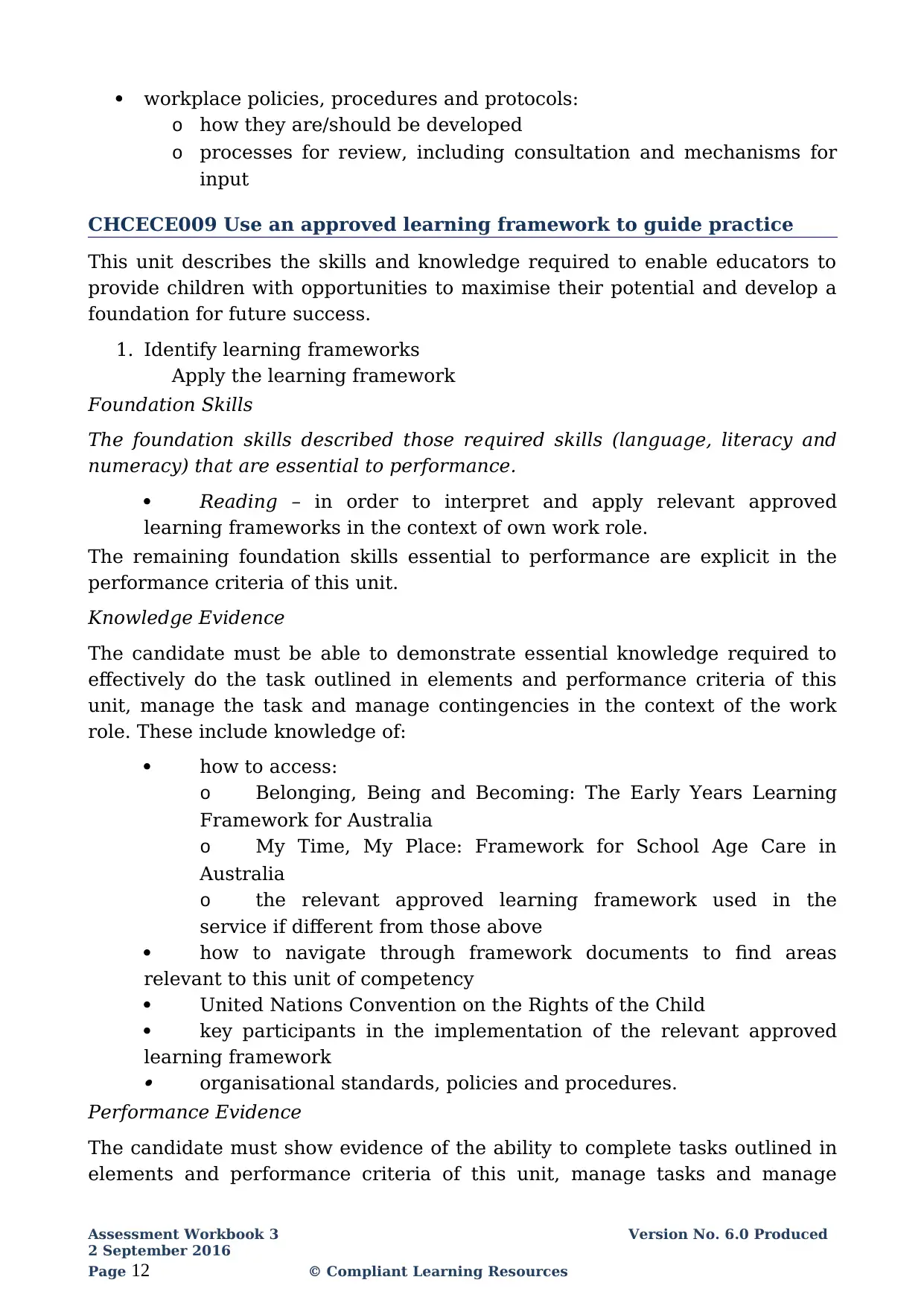
workplace policies, procedures and protocols:
o how they are/should be developed
o processes for review, including consultation and mechanisms for
input
CHCECE009 Use an approved learning framework to guide practice
This unit describes the skills and knowledge required to enable educators to
provide children with opportunities to maximise their potential and develop a
foundation for future success.
1. Identify learning frameworks
Apply the learning framework
Foundation Skills
The foundation skills described those required skills (language, literacy and
numeracy) that are essential to performance.
Reading – in order to interpret and apply relevant approved
learning frameworks in the context of own work role.
The remaining foundation skills essential to performance are explicit in the
performance criteria of this unit.
Knowledge Evidence
The candidate must be able to demonstrate essential knowledge required to
effectively do the task outlined in elements and performance criteria of this
unit, manage the task and manage contingencies in the context of the work
role. These include knowledge of:
how to access:
o Belonging, Being and Becoming: The Early Years Learning
Framework for Australia
o My Time, My Place: Framework for School Age Care in
Australia
o the relevant approved learning framework used in the
service if different from those above
how to navigate through framework documents to find areas
relevant to this unit of competency
United Nations Convention on the Rights of the Child
key participants in the implementation of the relevant approved
learning framework
organisational standards, policies and procedures.
Performance Evidence
The candidate must show evidence of the ability to complete tasks outlined in
elements and performance criteria of this unit, manage tasks and manage
Assessment Workbook 3 Version No. 6.0 Produced
2 September 2016
Page 12 © Compliant Learning Resources
o how they are/should be developed
o processes for review, including consultation and mechanisms for
input
CHCECE009 Use an approved learning framework to guide practice
This unit describes the skills and knowledge required to enable educators to
provide children with opportunities to maximise their potential and develop a
foundation for future success.
1. Identify learning frameworks
Apply the learning framework
Foundation Skills
The foundation skills described those required skills (language, literacy and
numeracy) that are essential to performance.
Reading – in order to interpret and apply relevant approved
learning frameworks in the context of own work role.
The remaining foundation skills essential to performance are explicit in the
performance criteria of this unit.
Knowledge Evidence
The candidate must be able to demonstrate essential knowledge required to
effectively do the task outlined in elements and performance criteria of this
unit, manage the task and manage contingencies in the context of the work
role. These include knowledge of:
how to access:
o Belonging, Being and Becoming: The Early Years Learning
Framework for Australia
o My Time, My Place: Framework for School Age Care in
Australia
o the relevant approved learning framework used in the
service if different from those above
how to navigate through framework documents to find areas
relevant to this unit of competency
United Nations Convention on the Rights of the Child
key participants in the implementation of the relevant approved
learning framework
organisational standards, policies and procedures.
Performance Evidence
The candidate must show evidence of the ability to complete tasks outlined in
elements and performance criteria of this unit, manage tasks and manage
Assessment Workbook 3 Version No. 6.0 Produced
2 September 2016
Page 12 © Compliant Learning Resources
⊘ This is a preview!⊘
Do you want full access?
Subscribe today to unlock all pages.

Trusted by 1+ million students worldwide
1 out of 46
Related Documents
Your All-in-One AI-Powered Toolkit for Academic Success.
+13062052269
info@desklib.com
Available 24*7 on WhatsApp / Email
![[object Object]](/_next/static/media/star-bottom.7253800d.svg)
Unlock your academic potential
Copyright © 2020–2025 A2Z Services. All Rights Reserved. Developed and managed by ZUCOL.





